Manufacturers – can touring cars survive without them?
In this feature, we look at manufacturer support in the top three Super 2000 (currently) based championships and determine how much a championship can survive without manufacturer support
It’s not an easy place to be in touring car racing at the moment. Unlike the nineties heyday, no championship can get together more than half a dozen manufacturers in the same class anywhere in the world these days, including the pinnacle of motorsport, Formula One.
The World Touring Car Championship has recently seen the number of manufacturers competing take a rapid downturn, no doubt aided by the Global Economic Crisis.
However, support is still there from SEAT and BMW, even though Chevrolet are the only committed manufacturer targeting the championship this year, whilst Volvo run an evaluation team preparing for a 2012 entry.
So, how much manufacturer support has there been for touring car racing in the last decade, and what effect has it really had on grid sizes?
The British Touring Car Championship has one of the most interesting trends in manufacturer involvement in the post Super Touring era. The change to the ‘British Touring Car’ specification in 2001 saw a low average number of entries in its first season, the year where Jason Plato took his first BTCC title. Just nine cars on average competed that season in the BTC-Touring class, with a minimum of eight for the opening round of the season.
Just two manufacturers were committed for the full season, but the Vic Lee-run Peugeot outfit were no match for Triple Eight’s new Vauxhall Astra Coupe. The Asta took 25 wins from 26 races, with only a late entry from West Surrey Racing with the MG Z-S spoiling the party at a wet Brands Hatch.
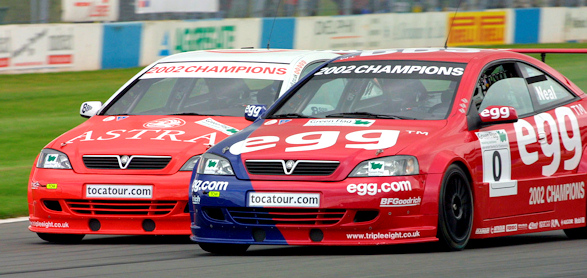
In 2002, the BTCC attracted a total of four manufacturers, all of which stayed on through to 2003. Honda joined they fray with Arena Motorsport, and MG’s works effort with West Surrey Racing did its first full season with four cars in ’02. Proton were also a new entry with the Impian. However, the Vauxhall was still dominant car, winning the manufacturers title right up until 2007, and with James Thompson and Yvan Muller sharing the drivers’ titles up to 2005.
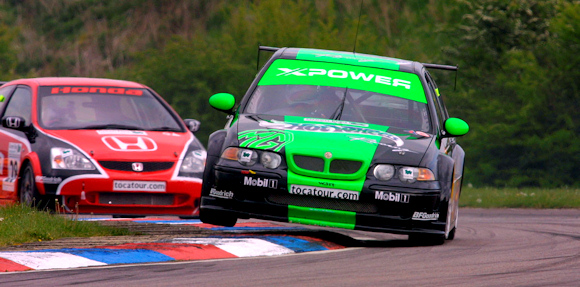
Grid sizes almost doubled through 2002, and stayed the same into 2003. From 2004 Super 2000 cars were allowed in and the grid sizes increased even more as cars from the European Touring Car Championship were now eligible to be used by the various independent runners.
MG officially dropped out in 2004, though West Surrey Racing would keep running the car up until 2007, but new was SEAT UK, with a pair of Toledo’s for 2003 SEAT Cupra Champion Rob Huff, and the returning Jason Plato.
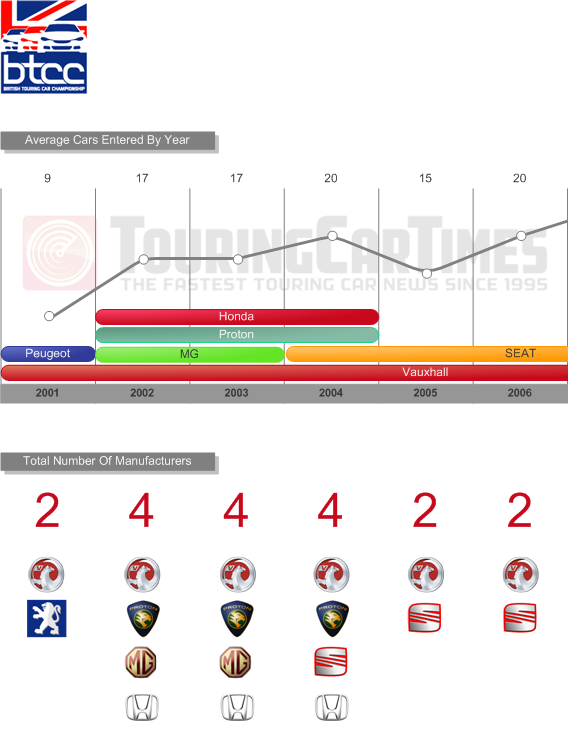
SEAT were the only manufacturer to break Vauxhall’s winning streak in the manufacturers titles, taking the title in 2006 with the new Leon.
Grid sizes remained stable between 2006 and 2008 whilst SEAT and Vauxhall battled away as the only manufacturers, though both were caught out in 2005 and 2006 with the dominant Honda Integra, independently built by Team Dynamics and taking two teams’ and drivers’ titles.
SEAT also came close in 2008 with the new TDI powered SEAT Leon before withdrawing from the BTCC, leaving Vauxhall as the only manufacturer in 2009.
2009 was one of the most competitive seasons in recent years despite SEAT’s withdrawal. For only the third time in BTCC history, an independent driver won the title, with Colin Turkington sealing his first crown at Brands Hatch for West Surrrey Racing ahead of Jason Plato, running in an independently entered Lacetti by RML – with Vauxhall driver Fabrizio Giovanardi in third.
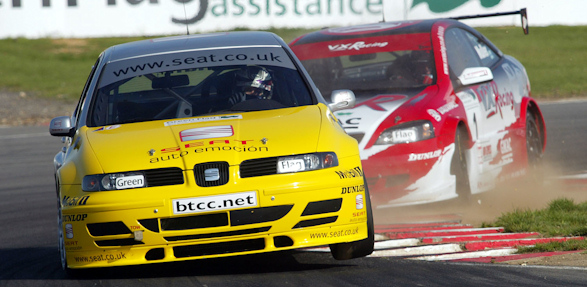
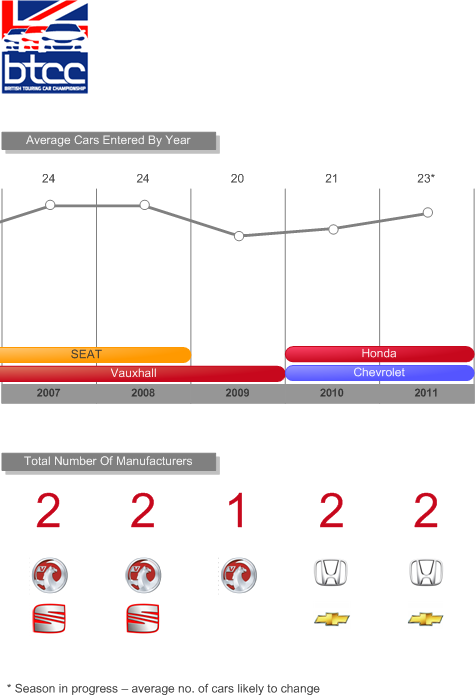
BTCC Series Director Alan Gow had been preparing for the downturn in manufacturers. During 2009 the blueprint for the future of the BTCC had been established with the ‘Next Generation Touring Car’. This would be a low cost option which would make it possible for the teams to build cars without the big budgets needed from car manufacturers, and even encourage smaller teams to construct their own chassis leading to an increased variety of models on the grid.
This was a very different approach from the World Touring Car Championship, which still depended upon manufacturer support with long distance travel to races and appealing to global car markets, and was continuing with high cost engines and Super 2000 cars.
In 2010, the BTCC saw a further increase in the size of the grid, with 23 cars registered for the season, with an average of 21 cars seen across the year.
Chevrolet saw an opportunity, especially with sister General Motors company Vauxhall gone, to back RML’s effort, and so there was still a manufacturer involved in 2010 after all. And then suddenly there were two, as Honda came back after a five year absense to back Team Dynamics, who had been racing Honda cars since 2004. This gave the team a works standard driver line-up in Gordon Shedden and Matt Neal, who went on to give Honda its first ever BTCC manufacturers title in 2010.
Chevrolet and Honda have stayed on for 2011, and the potential grid size could see the BTCC’s best yet with several more entries slated to join later in the season. A provisional entry list of 27 cars, if met, will see the highest number of cars take part since 26 cars were entered at the 2007 season finale at Thruxton.
The BTCC has set itself up to survive without manufacturers, whereas other series have a larger dependance on them.
The Scandinavian Touring Car Championship (nee Swedish) switched to the FIA Super 2000 model in 2003, and has enjoyed the highest level of manufacturer involvement in any touring car series across the world, with no less than four committed in any one season. The top number of manufacturers involved was with a peak of six in 2007 (Volvo, BMW, Honda, Audi, Opel & Chevrolet).
BMW and Volvo have been staunch supporters of the STCC, represented in every season in the S2000 era. Recent years have also seen Chevrolet and Volkswagen join the fold, which means Chevrolet is now represented at a works level in all three of the ‘big three’ S2000 championships.
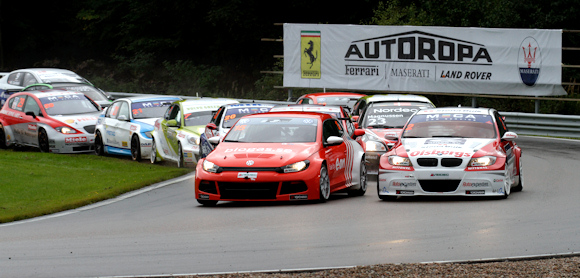
However, the average number of entries has never peaked above 22 for a season, with less than 20 cars in the last two years, but with a high level of competition at the front between the works BMW, Volvo & Volkswagen manufacturer teams, and also with Chevrolet stepping up their challenge in 2011.
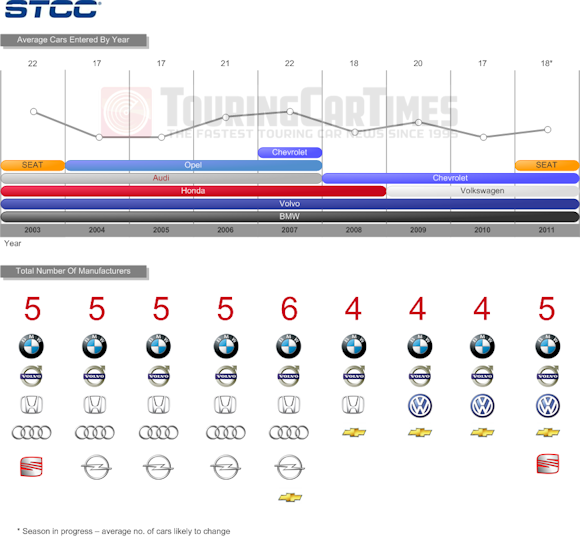
The World Touring Car Championship re-launched with five manufacturers in 2005. After an exploration year in 2004, Ford were back with the new shape Focus for German team Hotfiel, and Chevrolet launched its touring car programme with RML, moving across from running the SEAT team in the BTCC.
BMW, Alfa Romeo and SEAT also stayed on from the WTCC’s prior incarnation as the European Touring Car Championship, but the series top number of five manufacturers was for one year only, with Ford dropping out after 2005. The WTCC also achieved its best average grid size of 29 cars in their first season of operation.
For the next four years, the WTCC kept four manufacturers in place, whilst maintaining an average 26 car grid size, with Alfa Romeo leaving for Honda in ’08 (though the car was run by the same team, N-Technology), and then Lada coming in for just one year in ’09.
The Global Economic Crisis hit manufacturers hard, with SEAT pulling out at the end of 2009, albeit maintaining a presence with the independent SUNRED Engineering team.
BMW followed one year later, focussing on other programmes leaving Chevrolet almost on their own for 2011.
Despite this, SEAT and BMW’s support of their customer teams still means there is a healthy grid of 21 cars taking part in this year’s WTCC, and with a one car evaluation entry from Volvo on the grid, and interest from other manufacturers, it’s possible the competition at the top will increase in addition to the strong independents’ field.
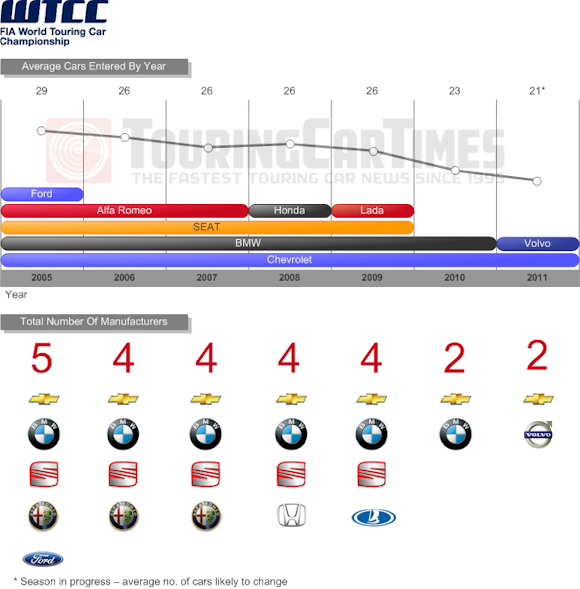
The trend seems to be that manufacturers don’t necessarily pull a lot of weight in terms of number of cars on the grid, but actually that stability and availability of cars for the independent teams does that instead.
The BTCC’s lowest points at the beginning of 2001 were due to a full change in car regulations with limited support from manufacturers and teams, and also with no cars available for the independents to run, except for a production class field bolted to the back.
In 2005, the rapid withdrawal of manufacturers in BTC-spec cars saw a sudden drop in grid sizes, but with S2000 cars becoming more accessable, it didn’t take long for the grid size to recover, and the championship was up to a record levelling 26 car grid in less than a year, and has maintained a level near that ever since despite no more than two manufacturers involved at a time since 2005.
The phased introduction of NGTC should see a similar changeover as was seen from the BTC-specification to S2000 between 2004 and 2007, and no control over the championship from manufacturers, whereas the STCC and WTCC would struggle or disappear without them, though they do attract some big name drivers with the better budgets available to them.
To see the full size graphic used in this feature, click below:











